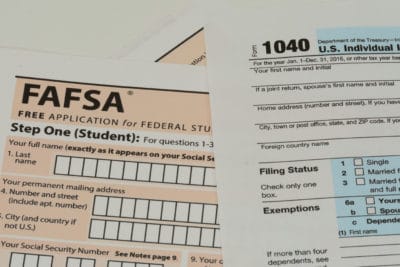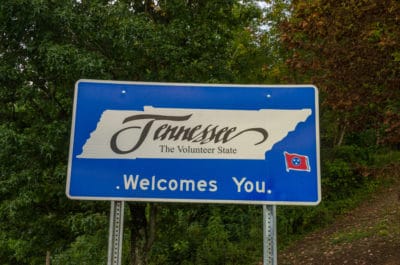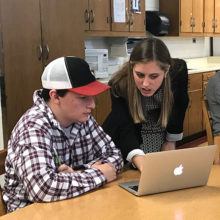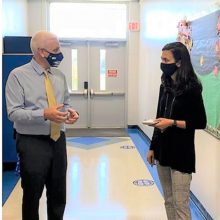
This is the second piece in a series on the FAFSA. Follow along with the rest of the series here.
As the school year wraps up — albeit under different circumstances than anyone expected — schools and districts are making one last push to encourage high school seniors to fill out the Free Application for Federal Student Aid, or the FAFSA. As of May 8, 2020, just half of North Carolina’s high school seniors had completed a FAFSA.
The FAFSA is a federal application that any student thinking about pursuing higher education, whether at a community college, public university, or private university, should fill out. Completing the FAFSA allows students to receive financial aid in the form of loans, grants, and scholarships from the federal government, many state governments, and postsecondary institutions themselves. Every student, regardless of family income, should complete it.
Completing the FAFSA is one step in the process of attaining a postsecondary degree, but it is a crucial one. FAFSA completion can mean the difference between going to college or not: Research shows that 90% of FAFSA completers attend college directly after high school, compared to just 55% of non-completers.
If North Carolina hopes to reach its myfutureNC attainment goal of two million working-age adults with a high-quality postsecondary degree or credential by 2030, increasing the number of students completing the FAFSA will be a crucial step in getting there. myFutureNC recently set a statewide FAFSA completion rate goal of 80% by 2030.
More recently, FAFSA completion has taken on added importance as many community colleges are now using it to determine which students are eligible for federal CARES Act student aid.
So, how is North Carolina doing? According to myFutureNC, North Carolina’s 2019 FAFSA completion rate was 64%, ranking the state 19th in the country. So far this year, however, only about 50% of high school seniors have completed the FAFSA. You can find the latest FAFSA completion rate data broken down by district and school by selecting North Carolina here. Keep reading to see a map of FAFSA completions by district, but first, a word about the data.
Related reading

FAFSA completion data
FAFSA data is reported by school and by district on a weekly basis. The school-level data is reported in two ways: applications submitted and applications completed. Submitting the FAFSA is the first step, but then the federal government must accept it. If there is anything missing or the government needs additional information, the application may be selected for verification. If selected for verification, students must provide the necessary additional information before their application can be marked complete — a vital step that can be overlooked by many students.
The data is also reported by application cycle. Each FAFSA application cycle remains open for 18 months, starting in October and closing in June a year and a half later. So, the 2020-2021 FAFSA opened on October 1, 2019, and will remain open until June 30, 2021. However, the earlier students fill out the FAFSA, the more financial aid they can receive, as financial aid often works on a first-come, first-serve basis. Additionally, many colleges and universities have deadlines for students to complete the FAFSA. The graphic below from Carolina Demography and myFutureNC illustrates the 2020-2021 application cycle.
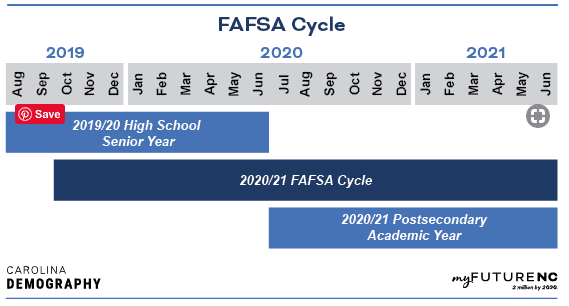
Current seniors who are planning on enrolling in college in the fall need to complete the FAFSA as soon as possible and shouldn’t wait until the end of the application cycle in June 2021. By that time, they will have (hopefully) completed their first year of college, and if they hadn’t completed the FAFSA, they would not have received any aid.
That said, students still have a few months before the 2020 fall semester will begin to complete the FAFSA, so North Carolina’s 2020-2021 FAFSA completion rate will likely increase.
Finally, this data only includes individuals who the federal government determines are high school seniors. Because there is no question on the FAFSA to ask if students are high school seniors, the government uses a number of measures to estimate who qualifies as a senior. Those include age (must be younger than 20) and whether the student is receiving a diploma versus a GED. Read more about who is included in these numbers here.
North Carolina ranks in the middle nationally for FAFSA completion rates
As of May 8, 54,843 North Carolina 12th graders had completed the 2020-2021 FAFSA. Depending on which number you use for the state’s total 12th grade enrollment, North Carolina’s FAFSA completion rate falls between 50.6% and 51.7% — well short of Tennessee and Louisiana, the two leading states with FAFSA completion rates of approximately 75% and 69%, respectively.
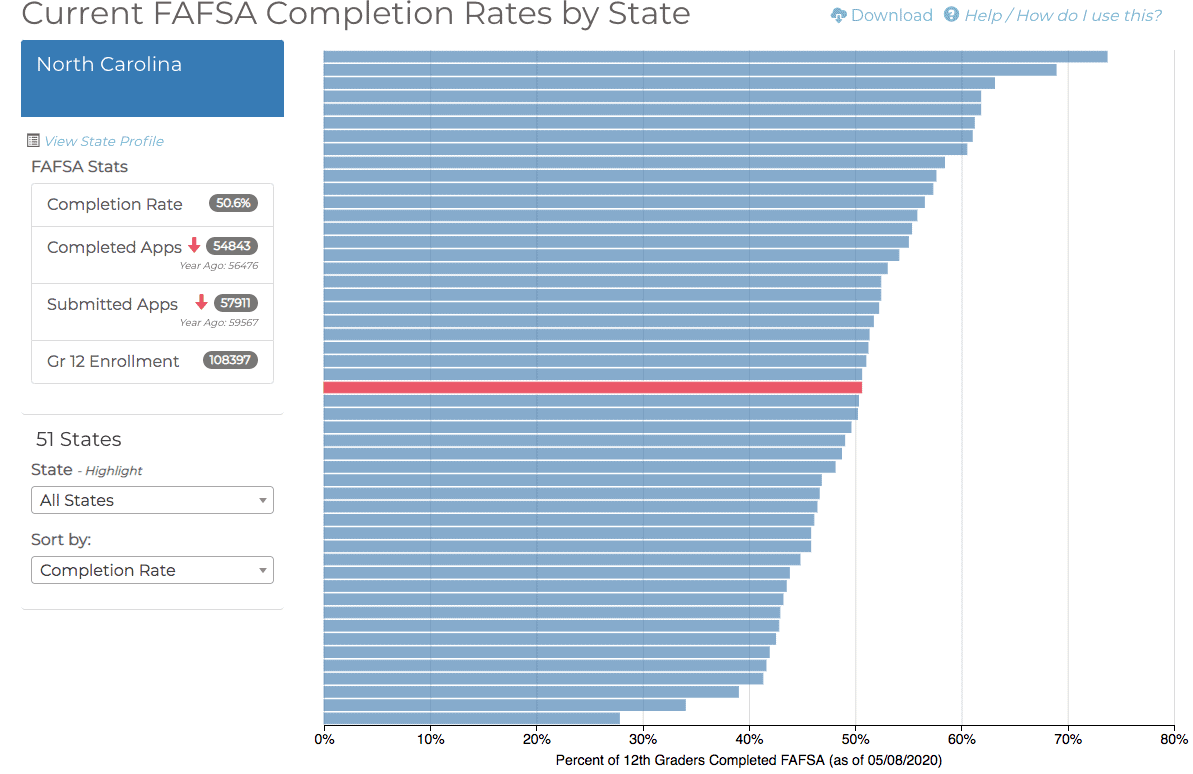
The map below shows the estimated FAFSA completion rates by Local Education Agency (LEA) for the 2020-2021 cycle as of May 8, 2020. For school districts, completion rates range from 20-24% at Columbus County Schools to 65-69% at Polk County Schools and Alleghany County Schools.
For charter schools (each one is a separate LEA), rates range from less than 20% at Carter G Woodson School, Charlotte Learning Academy, and Research Triangle High School to 75-79% at Community School of Davidson, Raleigh Charter High School, and Woods Charter School. There are also three charter schools with missing or insufficient data — Central Wake Charter High School, Stewart Creek High School, and Commonwealth High School.
Use the highlight by rate tool in the map below to see where different Local Education Agencies fall.
To view FAFSA completions by high school, select North Carolina and look at the tab titled “NC-School Level Data.” The data shows the number of applications submitted and completed. However, the data does not show the 12th grade enrollment at each school, so there is no completion rate. The data range from less than five applications completed so far at several schools to 455 at a few larger high schools.
The impact of COVID-19
Over the past three months, FAFSA completion rates have fallen behind compared to the same time period last year, leading many to raise concerns about FAFSA completion amidst the pandemic. According to the National College Access Network (NCAN), which runs the #FormYourFuture FAFSA Tracker, FAFSA completion rates were largely tracking last year’s rates until the pandemic hit. Starting March 13, FAFSA completion rates started trending downward when compared to the same time period last year.
“The class of 2020 now has 3.3% fewer FAFSA completions than last year’s class, representing 66,295 fewer seniors,” NCAN said in a news release following the release of the May 8 FAFSA data. High schools serving low-income students and those in rural areas and small towns are disproportionately seeing fewer FAFSA completions, the news release states.
NCAN also tracks FAFSA renewals. Students hoping to receive aid must submit a FAFSA renewal each year they attend college. NCAN reports, “Through April 30, there were 4.4% fewer FAFSA renewals total compared to last year, but among Pell-eligible students that figure was -5.5%.”
As NCAN points out, these numbers may rebound over the next few months after the initial disruption from the pandemic. However, the lower completion and renewal rates could also mean that fewer students are choosing to attend college next year as a result of the pandemic.
To learn more about the FAFSA, including how to complete the application and strategies for increasing the FAFSA completion rate, read the rest of the series here.
Behind the Story
Molly Osborne reported and wrote this piece. Analisa Sorrells created the map on FAFSA completion rates by LEA.
Recommended reading

